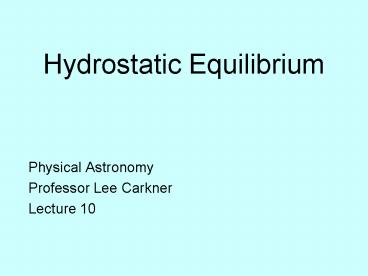Hydrostatic Equilibrium - PowerPoint PPT Presentation
1 / 15
Title:
Hydrostatic Equilibrium
Description:
How does the Voigt profile depend on wavelength? Increase l, increase width ... Radiation can't get through. Even with low opacity a lot of photons get absorbed ... – PowerPoint PPT presentation
Number of Views:357
Avg rating:3.0/5.0
Title: Hydrostatic Equilibrium
1
Hydrostatic Equilibrium
- Physical Astronomy
- Professor Lee Carkner
- Lecture 10
2
Questions
- How does the Voigt profile depend on wavelength?
- Increase l, increase width
- How does the Voigt profile depend on temperature?
- Increase T, increase width
- How does the Voigt profile depend on atomic mass?
- Increase m, decrease width
- How does the Voigt profile depend on number
density? - Increase n, increase width
- Goes as n
3
Stellar Interiors
- We cannot see stellar interiors directly
- Our theories on the interior of stars come from
stellar models - Key variables are pressure, temperature and
density as a function of radius
4
Equilibrium
- A star is just a big ball of gas
- Since the star is static, the two forces must be
equal - Force of gravity on small mass dm is
- Fg -(GMrdm)/r2
- Where r is the distance from the center of the
star and Mr is the mass interior to r
5
Pressure
- Since P F/A and dm rAdr, we can write
- dP/dr -GMrr/r2 -rg
- dP/dr is the pressure gradient
- Pressure decreases as we move towards the surface
6
Equation of State
- Is related to density and temperature
- Example ideal gas law
- Where N is number of particles and n is the
number density of particles - Remember ideal gas law is gets less accurate as
the density increases
7
Mean Weight
- n r/mmean
- We then define the mean molecular weight, m in
terms of the mass of hydrogen - m mmean/mH
- P rkT/mmH
8
Gas Composition
- If there are heavier elements, m increases
- For example, stars are mostly hydrogen with
significant helium and very small amounts of
heavier elements - If the gas is ionized, m decreases
- Ionized gas, m 0.62
9
(No Transcript)
10
Mass Continuity
- Mass is continuous
- dMr r(4pr2 dr)
- dMr/dr 4pr2 r
- The total mass is just the integral over the
whole star
11
Particle Energy
- Kinetic energy thermal energy
- ½mv2 (3/2)kT
- Eventually fast enough to overcome Coulomb
repulsion
12
Radiation Pressure
- Radiation pressure
- Prad (4s/3c)T4
- Note that Prad is strongly temperature dependant
13
Energy Transport
- Energy is transported in stars either by
convection or radiation - Convection dominates when
- Radiation cant get through
- Even with low opacity a lot of photons get
absorbed
14
Transport in Stars
- Low mass stars are un-ionized and have high
opacity (convection) - Near the cores of medium mass stars there is high
ionization and thus low opacity (rad then conv)
15
Next Time
- Read 10.3, 10.6, 11.1
- Homework 10.22, 10.23a, 11.1, 11.2a































